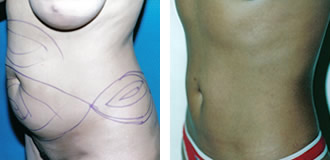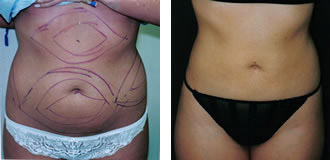LIPOSUCTION – TEN STEPS TO A SAFE AND SUCCESSFUL SURGERY
Posted On: February 09, 2006 Author: The Office of Dr. Stuart Linder Posted In: Liposuction, Plastic Surgery
Step 1: Find a Board Certified Plastic Surgeon, must be Diplomate in the American Board of Plastic and Reconstructive Surgery. There are no substitutes.
Step 2: Dr. Linder’s preferred technique is the “Tumescent Technique.” This is considered the safe and gold standard with the American Board of Plastic Surgery when performing liposuction in the United States, The ingredients of the tumescent fluid include three components; 1) Lactated Ringer or Sodium Chloride solution. This is used for hydrating the fat and allows the surgeon to remove the fat in a smooth distribution with reduced incidence of irregularities to the skin, 2) Lidocaine. The lidocaine is the numbing medicine or the local anesthetic that reduces pain postoperatively. 3) Epinephrine. The epinephrine will constrict the blood vessels, reducing blood loss and allowing for a safer and quicker postoperative recovery with less bruising.


Step 3: Small cannulas, Dr, Linder prefers the small 3 mm, triple lumen Mercedes cannulas to 1 atmosphere of vacuum suction pressure. The smaller tip cannulas that are blunt may reduce irregularities in the skin contour, skin surface, as well as denting, that is the most common complication with using larger cannulas.
Step 4: Use of a Board Certified anesthesiologist and placing the patient under general anesthesia. When the patient is completely under and put to sleep, this plastic surgeon can have 100% control of the patient, able to manipulate different areas and turn the body without the patient feeling pain or moving which can be dangerous in the operating room.

Step 5: Medicare and/or State Licensed Surgery Centers. This is useful for all forms of plastic surgery in that the center is certified and is of the utmost safety for the patient.
Step 6: Limit the amount of fat removed. The new standard with the American Board of Plastic Surgery and the American Society of Plastic Surgeons, limit the total amount of fat that should be removed at one setting. This is important in order to reduce the amount of blood loss that the patient will have during this operation.
Step 7: Addendum to Above, Decreased amount of fat can be removed when combined with other surgical procedures such as breast augmentation, breast lifts, tummy tucks, or facial plastic surgery procedures in order to reduce the amount of total estimated blood loss.
Step 8: Antibiotics should be used both in the operating room as well as postoperative for one week and sutures are normally removed by the surgeon on postop day seven.

Step 9: Compressive garments. This is extremely important, that postoperative compression garments be worn, including abdominal binders, as well as girdles to the thigh in order to allow smoothing and reduce edema and swelling of the abdomen and thigh areas postoperatively. Dr. Linder prefers his patients to wear the garments for at least six weeks postoperatively.
Step 10: Expect Realistic Results. If possible touch ups of small amounts of redundant fat in four to six months. Patient should review many of the doctor’s photographs and should be seen twice prior to surgery with the plastic surgeon. The areas should be marked out with a marking pen and looked at with the patient in a mirror to show what can and cannot be corrected. Expect realistic results and the patient will have a satisfactory and successful surgery.